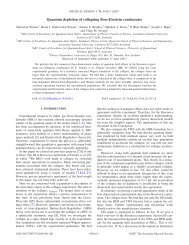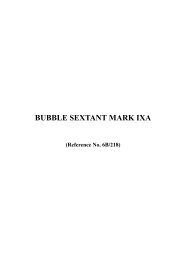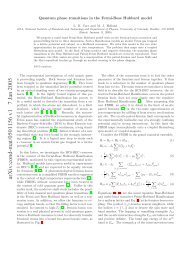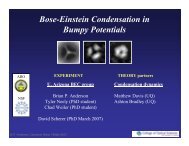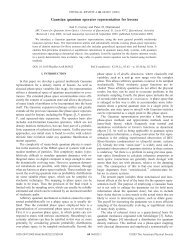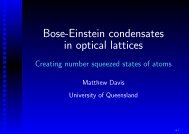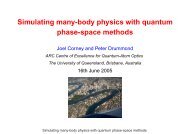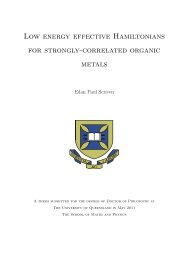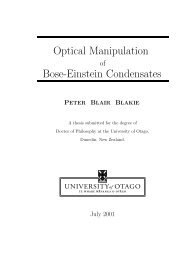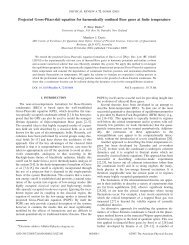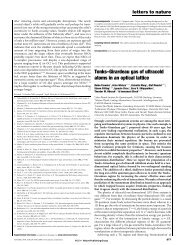7. <strong>Quantum</strong> simulations <strong>of</strong> evaporatively cooled <strong>Bose</strong> condensatesinvestigation into the quantum dynamics <strong>of</strong> <strong>Bose</strong> condensates. The methods used here canand must be further developed. Hence we will also discuss the limitations <strong>of</strong> the methodand also possible ways in which it may be improved to extend the results presented here.In Sec. 7.2 we will overview different approaches to tackling this problem and introducethe phase-space techniques that will be used. Section 7.3 gives the details <strong>of</strong> the positive-Pand Wigner methods, and also describes the physical system modelled in the simulations.Details <strong>of</strong> the numerical technique are given in Sec. 7.4, as well as the computationalconstraints that are placed on the range <strong>of</strong> physical situations that can be modelled. Thelargest section <strong>of</strong> this chapter (Sec. 7.5) contains the numerical results, and the thesisconcludes in Sec. 7.6 with a discussion <strong>of</strong> possible future directions.7.2 <strong>Quantum</strong> simulationsMany calculations <strong>of</strong> cooling dynamics have treated the cooling process classically[17,36, 101], <strong>of</strong>ten using the classical transport equation for either a truncated Boltzmanndistribution[8] or the more accurate truncated <strong>Bose</strong> distribution[183, 184]. This leads tothe question <strong>of</strong> how to handle the transition to the final quantum-dominated condensate.It is <strong>of</strong>ten assumed to be a canonical ensemble at a temperature estimated from theclassical theory with the final ensemble behaviour calculated from the mean-field Gross-Pitaevskii (GP) equation[11, 34, 96, 141]. Mean-field theory can only give semiclassical results,although some authors have included quantum corrections to the mean-field groundstate[15, 146, 189] to account for nonclassical features. Others have developed quantumkinetic theories, either through quantum corrections[175] to the GP equations or directlyfrom a master equation[64, 65, 66, 83, 92, 93]. These master-equation approaches are derivedin the weak-interaction limit in which the condensate states are taken to be low-lyingeigenstates <strong>of</strong> the trapping potential, populated from a thermal reservoir <strong>of</strong> excited atoms.The theory <strong>of</strong> Gardiner et al[63] enables a quantitative prediction <strong>of</strong> condensate growththat agrees well with experiment. In an alternative approach, Sto<strong>of</strong>[168] has derived aFokker-Planck equation for a Wigner function, which can be used to describe the kinetic,coherent and transition regimes <strong>of</strong> evaporative cooling, for the limits <strong>of</strong> both weak andstrong coupling. All <strong>of</strong> these quantum approaches make assumptions about how the statesevolve in order to achieve tractable calculations <strong>of</strong> measurable properties.143
7. <strong>Quantum</strong> simulations <strong>of</strong> evaporatively cooled <strong>Bose</strong> condensatesHowever, small atom traps are neither in the thermodynamic limit, nor necessarily ina steady state. A first-principles theory is required as a benchmark, for comparisons <strong>of</strong>these previous approximations. Computing the physics <strong>of</strong> quantum many-body systemsis a notoriously difficult problem; quantum mechanical objects reside in Hilbert space, thedimension <strong>of</strong> which grows exponentially with the number <strong>of</strong> particles. Thus even specifyingthe initial conditions precisely becomes prohibitive for large numbers <strong>of</strong> particles; aproblem which lead Feynman[58] to say:Can a quantum system be probabilistically simulated by a classical (probabilistic,I’d assume) universal computer? . . . If you take the computer to bethe classical kind I’ve described so far, . . . and there’re no changes in any laws,and there’s no hocus-pocus, the answer is certainly, No![58]However, the arguments that Feynman propounds to support this claim are not so conclusive.<strong>Quantum</strong> Monte Carlo (QMC) methods, for example, allow the simulation <strong>of</strong>quantum systems, albeit in imaginary time. Ceperley[29] revises Feynman’s conclusionsto prohibit only dynamical calculations in real time:The only way around this argument is to give up the possibility <strong>of</strong> simulatinggeneral quantum dynamics and to stick to what is experimentally measurable;arbitrary initial conditions cannot be realised in the laboratory anyway.[29]The initial conditions are not necessarily the problem. A system may begin in a classicallikestate, which requires few numbers to specify, but evolve nonclassical correlations andother quantum features over time. This is precisely what happens in the evaporativecooling <strong>of</strong> gases: the initial state is at a high temperature and described well by classicaldistributions; as energy is removed from the system, the gas approaches a critical regimein which quantum effects become important. Moreover, since the number <strong>of</strong> particles isrelatively small, the condensate may never reach equilibrium, thus requiring dynamicalsimulations to calculate measurable quantities.<strong>Quantum</strong> Monte Carlo (QMC) theories[28, 29] can be used to obtain first-principlescalculations <strong>of</strong> thermodynamic quantities even for very strong particle interactions[73], butcannot be applied practically to transient, nonequilibrium situations. They are applicableto the study <strong>of</strong> superfluidity and other condensed matter phenomena, which occur inisotropic systems in the thermodynamic limit. The extension <strong>of</strong> QMC methods into the144
- Page 1 and 2:
Open Quantum Dynamics of Mesoscopic
- Page 3 and 4:
AcknowledgementsMy thanks must firs
- Page 5 and 6:
AbstractThe properties of an atomic
- Page 7 and 8:
CONTENTS4 Continuously monitored Bo
- Page 9 and 10:
List of Figures2.1 Two-mode approxi
- Page 11 and 12:
LIST OF FIGURES7.5 Angular momentum
- Page 14 and 15:
LIST OF ABBREVIATIONS AND SYMBOLSI{
- Page 17 and 18:
1. Condensation ‘without forces
- Page 19 and 20:
1. Condensation ‘without forces
- Page 21 and 22:
Chapter 2Properties of an atomic Bo
- Page 23 and 24:
2. Properties of an atomic Bose con
- Page 25 and 26:
2. Properties of an atomic Bose con
- Page 27 and 28:
2. Properties of an atomic Bose con
- Page 29 and 30:
2. Properties of an atomic Bose con
- Page 31 and 32:
2. Properties of an atomic Bose con
- Page 33 and 34:
2. Properties of an atomic Bose con
- Page 35 and 36:
2. Properties of an atomic Bose con
- Page 37 and 38:
2. Properties of an atomic Bose con
- Page 39 and 40:
2. Properties of an atomic Bose con
- Page 41 and 42:
2. Properties of an atomic Bose con
- Page 43 and 44:
2. Properties of an atomic Bose con
- Page 45 and 46:
2. Properties of an atomic Bose con
- Page 47 and 48:
2. Properties of an atomic Bose con
- Page 49 and 50:
2. Properties of an atomic Bose con
- Page 51 and 52:
2. Properties of an atomic Bose con
- Page 53 and 54:
2. Properties of an atomic Bose con
- Page 55 and 56:
2. Properties of an atomic Bose con
- Page 57 and 58:
2. Properties of an atomic Bose con
- Page 59 and 60:
2. Properties of an atomic Bose con
- Page 62 and 63:
3. Homodyne measurements on a Bose-
- Page 64 and 65:
3. Homodyne measurements on a Bose-
- Page 66 and 67:
3. Homodyne measurements on a Bose-
- Page 68 and 69:
3. Homodyne measurements on a Bose-
- Page 70:
3. Homodyne measurements on a Bose-
- Page 75 and 76:
3. Homodyne measurements on a Bose-
- Page 77 and 78:
3. Homodyne measurements on a Bose-
- Page 79 and 80:
Chapter 4Continuously monitored con
- Page 81 and 82:
4. Continuously monitored Bose cond
- Page 83 and 84:
4. Continuously monitored Bose cond
- Page 85 and 86:
4. Continuously monitored Bose cond
- Page 87 and 88:
4. Continuously monitored Bose cond
- Page 89 and 90:
4. Continuously monitored Bose cond
- Page 91 and 92:
4. Continuously monitored Bose cond
- Page 93 and 94: 4. Continuously monitored Bose cond
- Page 95 and 96: 4. Continuously monitored Bose cond
- Page 97 and 98: 4. Continuously monitored Bose cond
- Page 99 and 100: 4. Continuously monitored Bose cond
- Page 101 and 102: 4. Continuously monitored Bose cond
- Page 103 and 104: 4. Continuously monitored Bose cond
- Page 105 and 106: 4. Continuously monitored Bose cond
- Page 107 and 108: Chapter 5Weak force detection using
- Page 109 and 110: 5. Weak force detection using a dou
- Page 111 and 112: 5. Weak force detection using a dou
- Page 113 and 114: 5. Weak force detection using a dou
- Page 115 and 116: 5. Weak force detection using a dou
- Page 117 and 118: 5. Weak force detection using a dou
- Page 119 and 120: 5. Weak force detection using a dou
- Page 121 and 122: 5. Weak force detection using a dou
- Page 123 and 124: Part IIQuantum evolution of a Bose
- Page 125 and 126: 6. Quantum effects in optical fibre
- Page 127 and 128: 6. Quantum effects in optical fibre
- Page 129 and 130: 6. Quantum effects in optical fibre
- Page 131 and 132: 6. Quantum effects in optical fibre
- Page 133 and 134: 6. Quantum effects in optical fibre
- Page 135 and 136: 6. Quantum effects in optical fibre
- Page 137 and 138: 6. Quantum effects in optical fibre
- Page 139 and 140: 6. Quantum effects in optical fibre
- Page 141 and 142: Chapter 7Quantum simulations of eva
- Page 143: 7. Quantum simulations of evaporati
- Page 147 and 148: 7. Quantum simulations of evaporati
- Page 149 and 150: 7. Quantum simulations of evaporati
- Page 151 and 152: 7. Quantum simulations of evaporati
- Page 153 and 154: 7. Quantum simulations of evaporati
- Page 155 and 156: 7. Quantum simulations of evaporati
- Page 157 and 158: 7. Quantum simulations of evaporati
- Page 159 and 160: 7. Quantum simulations of evaporati
- Page 161 and 162: 7. Quantum simulations of evaporati
- Page 163 and 164: 7. Quantum simulations of evaporati
- Page 165 and 166: 7. Quantum simulations of evaporati
- Page 167 and 168: 7. Quantum simulations of evaporati
- Page 169 and 170: 7. Quantum simulations of evaporati
- Page 171 and 172: A. Stochastic calculus in outlineco
- Page 173 and 174: Appendix BQuasiprobability distribu
- Page 175 and 176: B. Quasiprobability distributions u
- Page 177 and 178: Bibliography[1] Agrawal, G. P. Nonl
- Page 179 and 180: BIBLIOGRAPHY[22] Carter,S.J.Quantum
- Page 181 and 182: BIBLIOGRAPHY[45] Drummond, P. D., C
- Page 183 and 184: BIBLIOGRAPHY[68] Gordon,D.,andSavag
- Page 185 and 186: BIBLIOGRAPHY[92] Jaksch,D.,Gardiner
- Page 187 and 188: BIBLIOGRAPHY[114] Marshall, R. J.,
- Page 189 and 190: BIBLIOGRAPHY[135] Naraschewski, M.,
- Page 191 and 192: BIBLIOGRAPHY[158] Shelby, R. M., Le
- Page 193 and 194: BIBLIOGRAPHY[179] Wiseman, H. M. Qu
- Page 195:
. . . but this book is already too



